Clown fish: varieties and rules for keeping in an aquarium
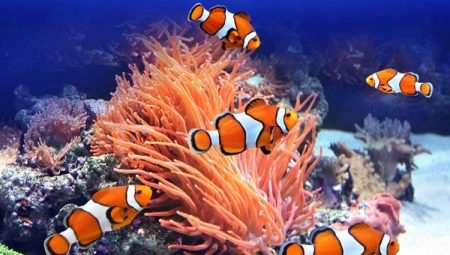
Clown fish are often purchased for young children who show interest in this creature after watching the cartoon "Finding Nemo", in which the main character was just the clown fish.
Despite the bright appearance and seeming simplicity of the fish, caring for it is considered rather difficult.
It will be difficult for a novice aquarist to organize optimal conditions for keeping, as well as to ensure correct breeding of the offspring.
Description
In nature, clownfish, the official name of which is amphiprion, lives in the coral reefs of the Pacific and Indian oceans.

It is important to understand that aquarium fish is not freshwater, as it prefers salt water, which largely determines the conditions for its maintenance. Her distant relative, the clown battle, lives in fresh water.
The clownfish looks relatively small - its size is in the range from 7 to 11 centimeters. The body is slightly torpedo-shaped and has a slight frog-like bulge on the forehead.
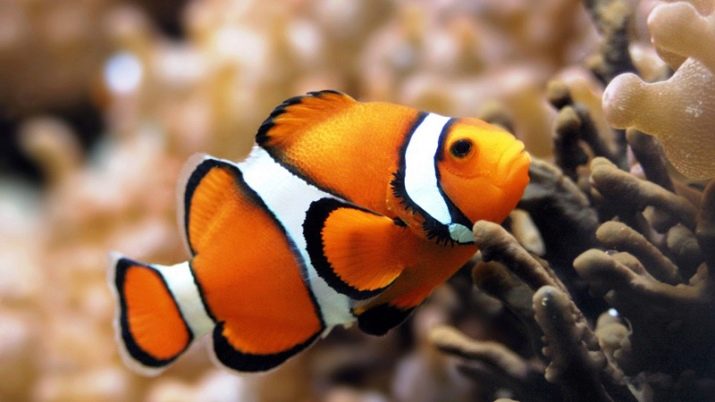
Black smart eyes are surrounded by a bright orange iris.
Regardless of age, the body of the fish is in most cases covered with stripes of rich orange, white and black colors.
Sometimes, however, there are amphiprions covered with blue stripes, or having a red or yellow pigment as the main tone. On the dorsal fin of the clown fish there is a characteristic notch, as if dividing it into two components. The pectoral fins are very dense and spiked, and the caudal fin is rather soft, but they all have a well-defined black outline.
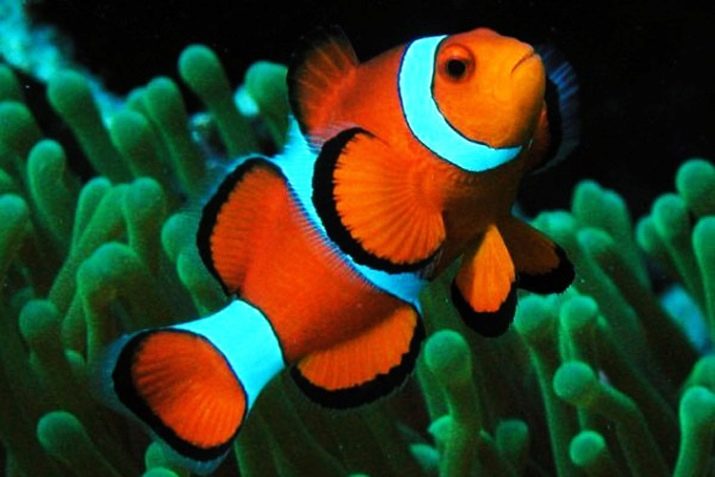
Under natural conditions, the fish lives for 10 years, but in aquarium conditions, the life expectancy can almost double... Amphiprion is born as a male, but after a while the largest representatives are transformed into females. If the female dies, then one of the males changes sex and takes her place.
Female representatives are much more aggressive than "men" and are slightly larger in size - about a centimeter.


Amphiprion differs from other inhabitants of the aquarium and unusual demeanor. For example, a creature even speaks in a peculiar way - it clicks, "grumbles" and makes other sounds. In nature, they prefer to live in symbiosis with anemones. The tentacles of the latter contain stinging cells, and therefore act as "protectors" for the fish.
Amphiprions themselves quickly lose sensitivity to burns due to the production of protective mucus.

They cleanse the anemones from dirt and organize the required water ventilation. In addition, they lure predators to the sea anemone, after which they feed on food debris. They also exchange other services.
Fish can exist both individually and in small schools.
In an aquarium, it is better to populate it together with anemones or, in the absence of such an opportunity, to organize the required number of grottoes and other shelters.
The clown fish gets along with almost all the inhabitants of the aquarium, but you should not choose sharks, eels and lionfish as neighbors for them.
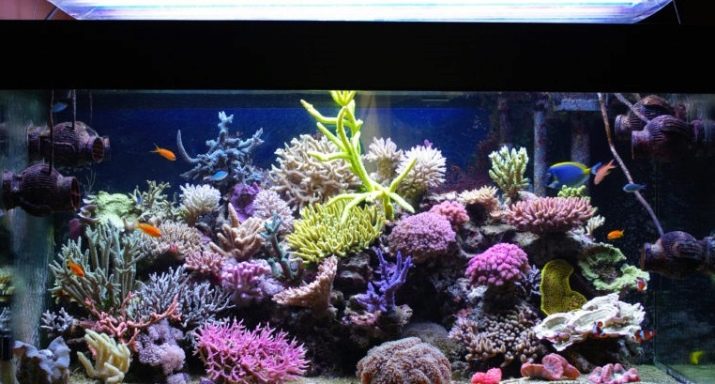
In general, within the framework of a school, a clown fish behaves rather unusual. Because initially, females are basically absent, then the community of fry appears to be purely males.
Their development to adulthood is largely determined by the existing hierarchy, since the largest male suppresses the growth and development of the rest. In addition, another large male transforms into a female, which is the only female in the community.
The size of the flock is determined by the size of the anemone. In addition, it is adjusted from the inside - as soon as the number of fish exceeds the norm, the smallest of them are expelled.
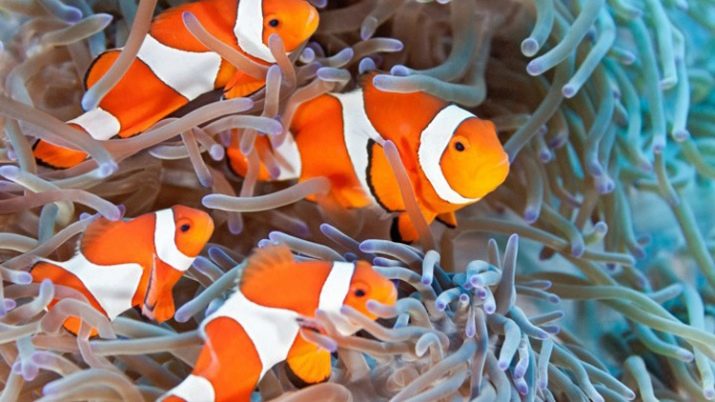
When several flocks are inhabited in one reservoir, collisions occur between them from time to time. To reduce the level of aggression, it is recommended to increase the number of anemones, grottoes and other shelters available in the tank.
Underwater inhabitants are gradually getting to know the anemone. At first, the individual slowly swims nearby, gradually touching it with different parts of the body. It starts with the fins, then the sides and, finally, the whole body. All this happens over an interval from several minutes to a couple of hours. This “acquaintance” should be enough for the amphiprion to develop a protective mucus, thanks to which interaction with the anemone will become complete.
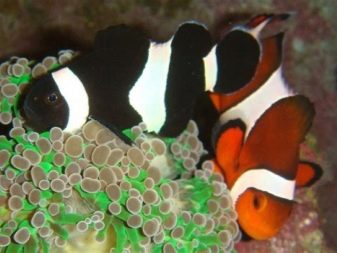
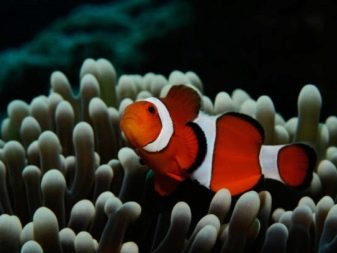
But if the fish is far from the anemone for a long time, then the substance may disappear.
Species overview
In clown fish, it is customary to distinguish 26 subspecies, differing from each other in color and in the shape of the stripes. One of the most popular is considered white-orange amphiprion ocellaris.
Its dimensions range from only 7 to 11 centimeters, and they live no more than 6 years. Although, of course, there are exceptions to the rules - there are cases when such a clown fish lived for 2 decades.
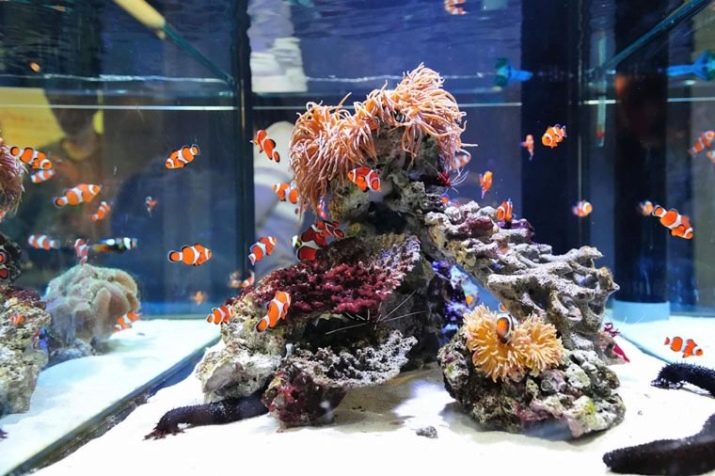
Ocellaris looks quite peaceful, but in fact quite often it bites other inhabitants of the aquarium and chews on the vegetation in the tank.
Clark's Clown has a chocolate color that looks very good with white stripes.
Although this species is quite unpretentious and requires only good water and high-quality lighting, it coexists very poorly with other fish, especially if the latter are smaller. Tomato clownfish, also known as red, is quite popular among aquarists due to its bright color, as well as its size reaching 14 centimeters.
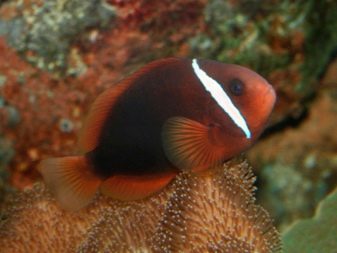
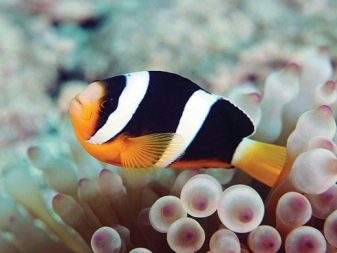
In addition, variegated, fiery, pink, saddle-headed and other amphiprions are popular among aquarists.
Features of the content
Keeping clown fish in an aquarium has its own specifics.
The volume of the tank should be at least 80 liters for a pair of individuals, and its dimensions should be at least 80x45x35 centimeters.
The ideal soil is coral sand with particle sizes ranging from 3 to 5 millimeters in diameter... You should plant live anemones inside, place corals and grottoes.

The temperature of the water must be maintained in the region of 25-26 degrees Celsius, and the acidity at the level of 8.1 to 8.4 pH.
Since clown fish are deep sea dwellers, it is important to maintain the required salt level in the aquarium, approximately 34.5 grams per liter.
The water will have to be changed either once a week, using 10% of the total volume, or every two weeks, but with twice the volume of liquid.
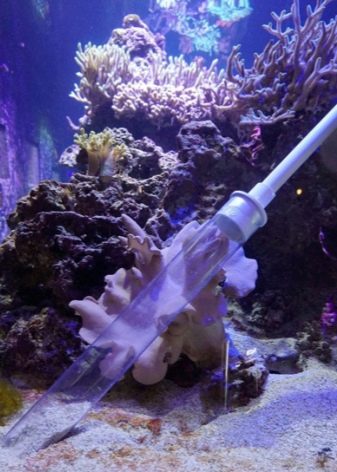
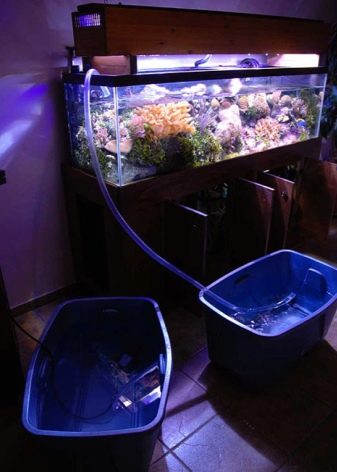
Procedures such as filtration, aeration and tank cleaning.
It is very important that the level of nitrites is normal, as the clown fish is extremely poorly tolerated by their excess.
Another required indicator is adequate lighting.
As for nutrition, amphiprion is completely undemanding in this matter, because in natural conditions it quite often picks up the remains of an anemone meal. Therefore, combined dry food intended for reef fish and live mixtures of shrimp, squid and shellfish are also suitable.
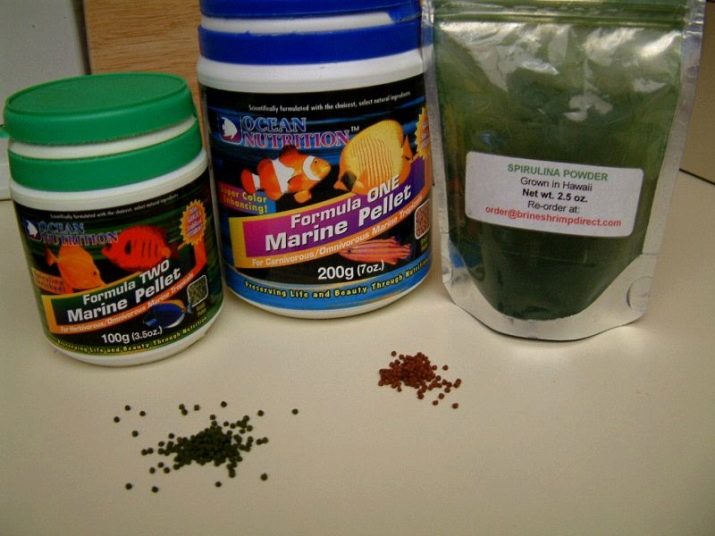
A good solution is a mixture of fish meat and algae, of which clowns prefer spirulina, blue-green or red bottom algae. Clowns are fed twice, or even three times a day, but always in small portions.
Large pieces will first have to be chopped.
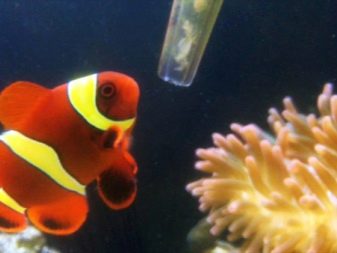
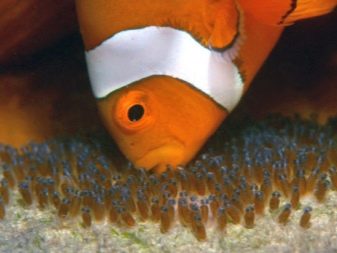
Fish of "adolescence" should be given an amount of food that is at least 6% of their total body weight.
Breeding
As mentioned above, initially the clown fish possesses both male and female reproductive organs, but in fact at birth it is a male.
During growth and development, large individuals transform into females and choose their sexual partners.
Moreover, each flock has a dominant pair of two large individuals, which are responsible for reproduction. If the female suddenly dies, the male will change sex and choose a new partner.
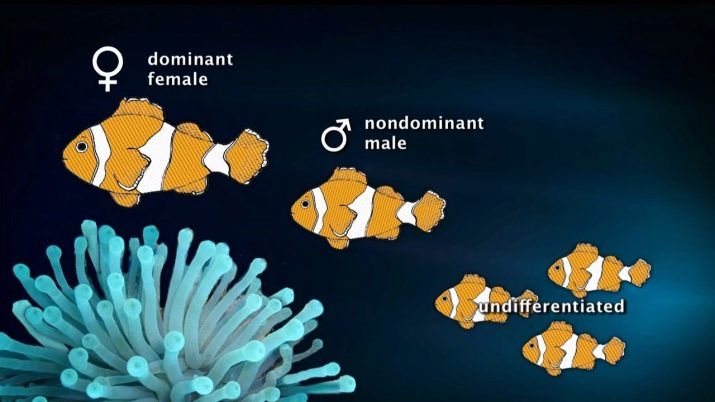
In nature, the moon becomes a kind of signal for males that it is time for them to be active.
In order for clown fish to feel as comfortable as possible during spawning, it is recommended to turn off the light in the aquarium for a period from 22 to 23 hours, and set the temperature to 26 degrees Celsius.
The female will spawn under the tentacles of the anemone on the leeward side, next to the corals or in the existing grottoes.
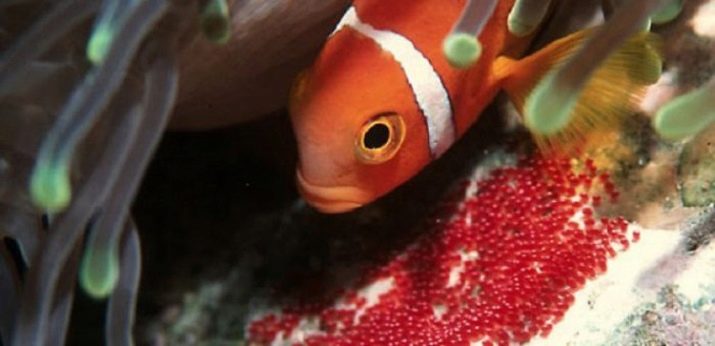
The selected place is pre-cleaned for several days. As a rule, spawning begins in the morning, and the process lasts for two hours. The male protects the clutch, ventilates it and cleans it from unfertilized units.
Sometimes the female helps him in protection. Due to the presence of warm waters, offspring can reproduce throughout the year. As a rule, during spawning, the female brings from several hundred to one and a half thousand eggs.
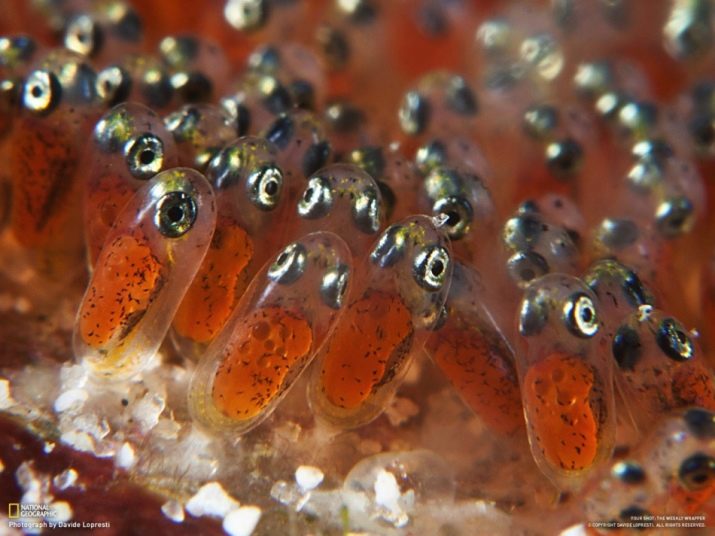
The exact amount will be determined based on the age and size of the female. The female is suitable for breeding until she is 12 years old.
The larvae hatch after about a week or a little later. They are immediately carried away by the anemones, so they simply "swing" in water streams for about 8-12 days. The emerging offspring will need regular plankton to feed.
After the above period, the fry will return to find their anemone.
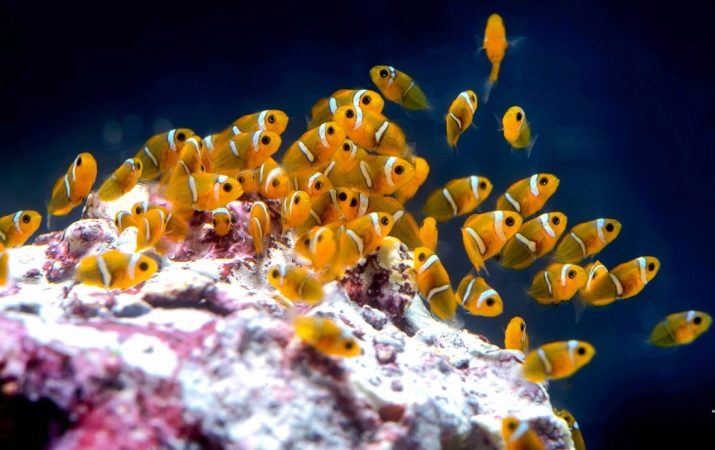
By the way, despite the fact that the male continues to guard the offspring until the eggs are transformed into fry, for a while, it is better to plant them from a common aquarium.
In this case, the growth and development of clowns will not suffer at all, but the danger of eating by other fish will disappear. It is recommended to replant fry when they are 2-3 weeks old.
When populating an aquarium, you should choose those fish that have already been born in the aquarium conditions.
Such a choice will allow acquiring creatures that are already adapted to the specifics of life in captivity, as well as with less stress enduring "travel".
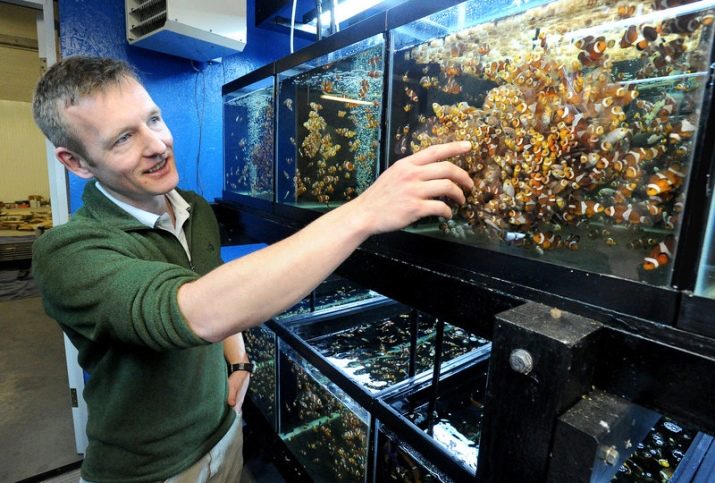
In addition, wild fish are the most common carriers of diseases such as brooklynellosis and cryptocaryosis. During transportation in aquariums with limited volume, they often die.
Careful examination of the creatures is required before purchasing. Clownfish should have bright coloration with smooth scales and clear eyes.
In behavior, it is important to track parameters such as mobility, activity and good mood. It is better to apply for a purchase to trusted suppliers who are able to present all the required papers. The cost of one individual varies from 1 to 4 thousand rubles, depending on the rarity of the species.
You can watch an informational video about clown fish and keeping it in the aquarium below.








